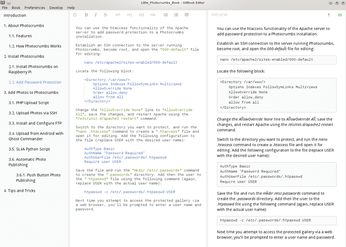

The format of figure/table numbers depends on if sections are numbered or not: if number_sections = TRUE, these numbers will be of the format X.i, where X is the chapter number, and i in an incremental number if sections are not numbered, all figures/tables will be numbered sequentially through the book from 1, 2, …, N. We strongly recommend you to use fig_caption = TRUE for two reasons: 1) it is important to explain your figures with captions 2) enabling figure captions means figures will be placed in floating environments when the output is LaTeX, otherwise you may end up with a lot of white space on certain pages.
#Gitbook editor set book image full
You can check out the help page of rmarkdown::html_document() for the full list of possible options. Most arguments are passed to rmarkdown::html_document(), including fig_caption, lib_dir, and. , template = "default", split_by = c( "chapter", "chapter+number", "section", "section+number", "rmd", "none"), split_bib = TRUE, config = list(), table_css = TRUE) Gitbook( fig_caption = TRUE, number_sections = TRUE, self_contained = FALSE, anchor_sections = TRUE, lib_dir = "libs", global_numbering = !number_sections, pandoc_args = NULL.

The output format function for the GitBook style in bookdown is gitbook(). We have also added some useful features in the user interface that we will introduce in detail soon. You can embed interactive content in the book (for HTML output only), such as HTML widgets and Shiny apps.The Markdown syntax is much richer: you can write anything that Pandoc’s Markdown supports, such as LaTeX math expressions and citations.
#Gitbook editor set book image code
You can embed R code chunks and inline R expressions in Markdown, and this makes it easy to create reproducible documents and frees you from synchronizing your computation with its actual output ( knitr will take care of it automatically).The most significant one is that we replaced the Markdown engine with R Markdown v2 based on Pandoc, so that there are a lot more features for you to use when writing a book: We have made several improvements over the original GitBook project. If you do not use RStudio or prefer a function, you can create the same project template with bookdown::create_gitbook() from your R console. The easiest way to get started writing a new gitbook is to use the RStudio Project Wizard ( File > New Project > New Directory > Book project using bookdown) and select gitbook from the dropdown menu (see Figure 3.3). The design is responsive to the window size, e.g., the navigation buttons are displayed on the left/right of the book body when the window is wide enough, and collapsed into the bottom when the window is narrow to give readers more horizontal space to read the book body. It provides a beautiful style, with a layout consisting of a sidebar showing the table of contents on the left, and the main body of a book on the right. The GitBook style was borrowed from GitBook, a project launched by Friendcode, Inc. ( ) and dedicated to helping authors write books with Markdown. 6.2.6 Optional: change the default subdomain.6.2.1 The build-and-deploy pipeline sequence.


 0 kommentar(er)
0 kommentar(er)
